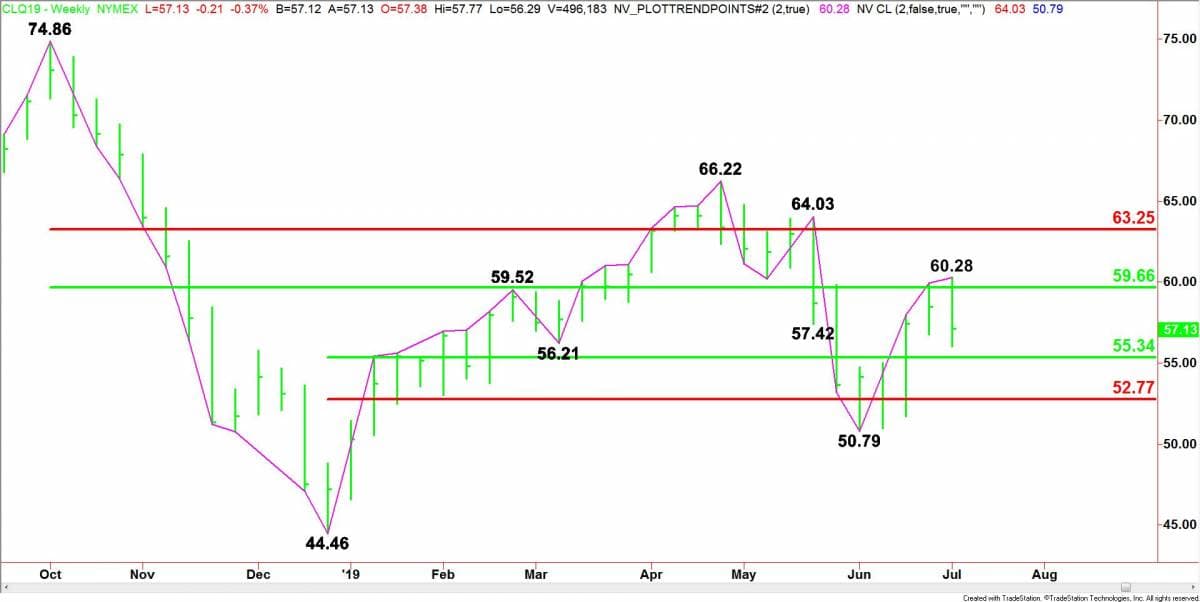U.S. West Texas Intermediate crude oil futures are showing signs of a successful support base on the daily chart, but are still in a position to close lower for the week. Nonetheless, the rally on Friday after a steep sell-off on Wednesday suggests the worst of the recent selling may be over at least in the short-run.
The market had been pressured throughout the week amid concerns that global economic weakness will lead to lower demand. However, losses are likely being limited by worries that an escalation of tensions between the U.S. and Iran will lead to a supply disruption.
It seems this week that each piece of potentially bullish news was outweighed by a developing concern.
Earlier in the week, OPEC and its allies agreed to extend their plan to trim production, reduce inventory and stabilize prices for nine-months, or until March 2020. On paper, this is potentially bullish. After all, virtually the same strategy has been holding up prices since January 1. However, some traders wanted to see bigger cuts to offset increasing U.S. shale production.
On Wednesday, the U.S. Energy Information Administration (EIA) reported a weekly decline of only 1.1 million barrels in crude stocks. This was lower than the forecast and much smaller than the 5 million barrel draw reported late Tuesday by the American Petroleum Institute (API). The discrepancy suggests that oil demand could be slowing amid signs of a weakening U.S. economy.
With data from the EIA…
U.S. West Texas Intermediate crude oil futures are showing signs of a successful support base on the daily chart, but are still in a position to close lower for the week. Nonetheless, the rally on Friday after a steep sell-off on Wednesday suggests the worst of the recent selling may be over at least in the short-run.
The market had been pressured throughout the week amid concerns that global economic weakness will lead to lower demand. However, losses are likely being limited by worries that an escalation of tensions between the U.S. and Iran will lead to a supply disruption.
It seems this week that each piece of potentially bullish news was outweighed by a developing concern.
Earlier in the week, OPEC and its allies agreed to extend their plan to trim production, reduce inventory and stabilize prices for nine-months, or until March 2020. On paper, this is potentially bullish. After all, virtually the same strategy has been holding up prices since January 1. However, some traders wanted to see bigger cuts to offset increasing U.S. shale production.
On Wednesday, the U.S. Energy Information Administration (EIA) reported a weekly decline of only 1.1 million barrels in crude stocks. This was lower than the forecast and much smaller than the 5 million barrel draw reported late Tuesday by the American Petroleum Institute (API). The discrepancy suggests that oil demand could be slowing amid signs of a weakening U.S. economy.
With data from the EIA and API seemingly offsetting the OPEC-led attempt to stabilize inventory and prices, the wild card remains the relationship between the United States and Iran.
According to the timeline, concern about the possibility of US military action against Iran has grown since the administration cited new intelligence that Iran or its proxies were planning to attack U.S. troops or American tourists in the Middle East.
Furthermore, the United States blamed Iran for attacks on oil takers near the Strait of Hormuz, and most recently, Iran shot down a U.S. drone.
Earlier this week, President Hassan Rouhani’s said that Iran could enrich to “any amount we want” in the absence of a nuclear deal. This prompted President Trump to warn him to “be careful with the threats… they can come back to bite you like nobody has been bitten before.”
In the meantime, the Trump administration continues to lay the legal groundwork for a strike.
On Friday, the market is getting a boost from a strong headline number in the June Non-Farm Payrolls report. The news dampens the chances of a Federal Reserve rate cut later this month. Furthermore, it weakens the case for lower domestic demand. This is helping to drive weak short-sellers out of the market ahead of the weekend.
Technical Analysis
Weekly August WTI Crude Oil Technical Analysis

The main trend is down according to the weekly swing chart. The main trend will change to up on a move through $64.03. A trade through $50.79 will signal a resumption.
This week’s outside move, lower close indicates a secondary lower top at $60.28 may be forming. This move also reaffirms the existing downside momentum. Taking out this minor top will shift momentum back to the upside.
The main range is $74.86 to $44.46. Its retracement zone at $59.66 to $63.25 is resistance. This zone stopped the rally this week at $60.28.
The short-term range is $44.46 to $66.22. Its retracement zone at $55.34 to $52.77 is support. This zone prevented the market from continuing its steep sell-off throughout June.
Technical Forecast
Based on this week’s price action, the direction of the September WTI crude oil market this week is likely to be determined by trader reaction to the 50% level at $59.66.
Bearish Scenario
A sustained move under $59.66 will continue to indicate the presence of sellers. The next downside target is the short-term 50% level at $55.34. Watch for counter-trend buyers on the first test of this level.
If $55.34 fails as support then look for a potential acceleration to the downside with the next target the short-term Fibonacci level at $52.77. This is followed closely by the $50.79 main bottom.
Bullish Scenario
Holding a test of $55.34 will signal the return of buyers. If this move creates enough upside momentum then look for a retest of $59.66. Overcoming this level will indicate the buying is getting stronger. Taking out $60.28 will indicate a shift in momentum to the upside. If this move is able to generate enough upside momentum then look for the rally to possibly extend into $63.25, followed by $64.03.
Overview
The mixed news is helping to hold the market between a pair of 50% levels at $59.66 and $55.34. It could continue ping-ponging inside this range over the near-term. Pressuring the market will be concerns over a potential global economic slowdown or recession, and increasing U.S. production.
Underpinning the market will be the OPEC-led supply cuts and the sanctions against Iran and Venezuela. Speculative buyers could continue to provide support on the hopes of a supply disruption in the Middle East.
The wildcard is U.S.-China trade relations. At this time, both economic powerhouses are preparing to resume trade talks. This could be a positive. Upside momentum could pick up if there are developments that move both parties toward an eventual trade deal.


















